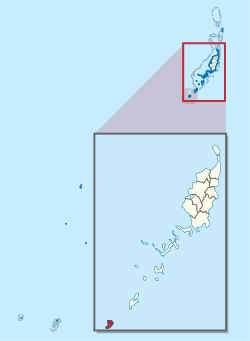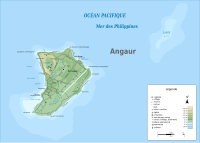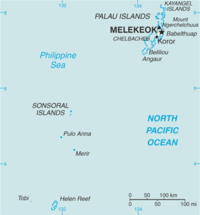Angaur
This articleneeds additional citations forverification.(June 2009) |
Angaur
アンガウル châu Angauru | |
|---|---|
 Location of Angaur inPalau | |
| Coordinates:6°54′33″N134°08′20″E/ 6.9092°N 134.1388°E | |
| Country | |
| Capital | Ngeremasch |
| Area | |
| • Total | 8 km2(3 sq mi) |
| Population (2015 Census) | |
| • Total | 119 |
| • Density | 15/km2(39/sq mi) |
| • Official languages | Palauan English Japanese |
| Time zone | UTC+9(Palau Standard Time) |
| Area code | (+680) 277 |
| ISO 3166 code | PW-010 |
Angaur(Japanese:アンガウル,Hepburn:Angauru),orNgeaurin Palauan, is an island and state in theisland nationofPalau.
History
[edit]


Angaur was traditionally divided among some eight clans. Traditional features within clan areas represent important symbols giving identity to families, clans and regions. These features include a variety of stone platforms with historical and traditional importance. Traditional cemeteries are frequently located in or around some of these stone platforms. The large quantities of shell recovered from archaeological sites gives evidence for an intensive exploitation of the limited lagoon surrounding the island and for collecting and fishing outside of the reef as well. On the island, the localized areas of soil were intensively used for garden plots.[1]
The first sighting of Angaur,Babeldaob,Koror,andPeleliurecorded by Westerners was by the Spanish expedition ofRuy López de Villalobosat the end of January 1543. They were then charted asLos Arrecifes(The Reefs in Spanish).[2]In November and December 1710, these three islands were again visited and explored by the Spanish missionary expedition commanded bySargento MayorFrancisco Padillaon board of thepatacheSantísima Trinidad.Two years later they were explored in detail by the expedition of Spanish naval officer Bernardo de Egoy.[3]
From 1909 until 1954phosphatemining took place on Angaur, originally by the Germans, then the Japanese, and finally by Americans. Angaur is the site of a majorWorld War IIbattle. TheBattle of Angaurwas part of the larger offensive campaign calledOperation Foragerthat ran from June to Nov 1944. Many American and Japanese battle relics[4]remain scattered throughout the island. The 7th Antiaircraft Artillery Battalion under Lieutenant colonelHenry R. Paigeserved as garrison forces for the remainder of the War. Angaur is the only place in Micronesia that has feral monkeys; they are descended frommacaquesthat escaped during the period of German occupation.[5]Thus it is also called Monkey Island.
Angaur is accessible by boats and small planes, andBelau Airhas service toAngaur Airstrip.From 1945 to 1978 the U.S. Coast Guard operated aLORANtransmitting station, LORSTA Palau, as part of the worldwide LORAN navigation system.
Geography
[edit]Angaur is a coralline island located some 10 km southwest ofBeliliouat the southern tip of the main group of islands in the archipelago, and is situated outside of the lagoon and enclosing reef for this main group. Angaur is surrounded by a thin reef which encloses a narrow lagoon, though for the most part the reef is so small and low that it offers little impediment to the waves which break directly on the steep cliffs which ring the island. Distinct from therock islandswhich lie between Beliliou andKoror,Angaur is a raised platform island. The profile of the island is a low table with very little relief. The highest point on the island, a small hill northwest of Rois, is only 40 m above sea level, and most of the island is less than 10 m above sea level. On the ground, however, the terrain is very rugged with steep, jagged outcrops of ancient reef rising unpredictably in a tangled maze. To the northwest the ground is slightly higher, and to the southeast the ground is slightly lower with marshy swamps across thekarsticlandscape.[1]
Modern settlement on Angaur is concentrated on the west coast south of the harbor to a point of land called Bkul a Usas. Separated by lines of social division are the modern villages of Rois and Ngaramasch.[1]
Most of Angaur is covered with a mixed limestone forest which includes several small stands ofcasuarinaforest (ironwood orngas trees). Surrounding the modern villages and many houses are garden plots and interspersed with these are small pockets ofagroforest(a variety of trees providing useful domestic products and foodstuffs). A large area oftaroswamp gardens known as Ngetkebui lies in the southern part of the island.[1]
The island, which forms its own state, has an area of 8 km2(3 mi2). Its population was 130 in 2012.[6]The statecapitalis the village ofNgeremaschon the western side. A second village, Rois, is immediately east of Ngeremasch. Angaur Island is located southwest ofPeleliu,and it is a popular surfing location.
Phosphate
[edit]Long before people came to this part of the Pacific Ocean, Angaur was a nesting ground for large numbers of birds whose droppings would eventually becomephosphatedeposits. In the early part of the 20th century,phosphate mineswere started in the rugged terrain in the northwest part of the island and along the east coast. These mines, started during the German administration, were in operation periodically for three administrations ending in the 1950s in the American Period. The mined phosphate was initially processed and loaded on ships at a small harbor on the west side of the island. Apparently this small natural harbor has been expanded during the course of phosphate mining. Also constructed with the harbor expansion was a lighthouse whose abandoned remains are situated on the high ground to the northwest.[1]
Demography
[edit]The population of the state was 119 in the 2015 census and median age was 43.3 years.[7]
History of the population:[6]

Ucherbelau is the title of the traditional high chief from the state.[8]
Languages
[edit]According to the state constitution of 1982, Angaur's official languages arePalauan(and the Angauran dialect in particular),EnglishandJapanese.[9][10]It is the only place in the world where Japanese is ade jureofficial language, as it is only thede factoofficial language ofJapan.At the time the constitution was written, many of the elders participating in the process had been educated in Japanese, as was the practice once Japan gained control ofSouth Seas Mandatein 1914.[11]
However, the results of the 2005 census show that in April 2005 there were no usual or legal residents of Angaur aged 5 or older who spoke Japanese at home at all.[12]No residents of Anguar reported themselves or were reported as being ofJapaneseethnic origin.[13]One person born (but apparently not residing) on Angaur reported to speak Japanese and Palauan equally often at home.[12]The 2012 mini census showed 7 people aged 10 or olderliteratein any language other than Palauan and English for Angaur, out of a total population of 130.[6]
Political system
[edit]The state of Angaur, with population of less than 150, has an elected chief executive, governor. The state also has a legislature elected every two years.[14]The state population elects one of the members of theHouse of Delegates of Palau.
Transport
[edit]The island is connected by a network of roads. Secondary roads radiate out across the island and almost encircle it. On the east side of the island is a landing strip constructed during the Japanese administration. Although unimproved, the 6600 foot runway known as theAngaur Airstripis used for the single-engine plane serving Angaur with daily flights from theAiraiairport. The presence of the runway played an important role in the decision by the Americans to take Angaur along withBeliliouduring World War II. Unlike the battle of Peleliu, however, Angaur received much less shelling before the invasion and the battle did not entail the tragic loss of life witnessed on Beliliou.[1]
Education
[edit]TheMinistry of Educationoperates public schools.
Angaur Elementary School was established in 1945. A new building in another location opened in 1953. It moved to the original site in 1966 in a new building but it later moved back to the second site.[15]
Palau High Schoolin Koror is the country's only public high school, so children from this community go there.[16]
Tourism
[edit]It is a very popular place for surfing. In 2003, the Palau National Congress legalizedcasino gamblingon the island.
Among other attractions are the cemetery of planes and ships that were destroyed in World War II, a Buddhist memorial honoring the Japanese fallen in combat and a small Japanese Shinto shrine.
See also
[edit]References
[edit]- ^abcdefSnyder, David.; Adams, William Hampton; Butler, Brian M. (1997).Archaeology and historic preservation in Palau.Anthropology research series / Division of Cultural Affairs, Republic of Palau 2. San Francisco: U.S. National Park Service.
- ^Burney, JamesA chronological history of the discoveries in the South Sea or Pacific Ocean,London, 1813, v.I, p.233.
- ^Coello, Francisco "Conflicto hispano-alemán"Boletín de Sociedad Geográfica de Madrid,t.XIX. 2º semestre 1885, Madrid, p.296.
- ^Panoramio photosArchived2014-12-19 at theWayback Machineof Japanese command post on north end of Angaur Island, Palau.
- ^Micronesia Handbook by Neil M. Levy, pp. 174–176
- ^abc"2013 ROP Statistical Yearbook"(PDF).Bureau of Budget & Planning.Retrieved4 August2014.
- ^"2015 Census of Population, Housing and Agriculture for the Republic of Palau"(PDF).Palau Government.Office of Planning and Statistics.
- ^"Council of Chiefs – PalauGov.pw".
- ^"Constitution of the State of Angaur".Pacific Digital Library. Article XII.Retrieved4 August2014.
The traditional Palauan language, particularly the dialect spoken by the people of Angaur State, shall be the language of the State of Angaur. Palauan, English and Japanese shall be the official languages.
- ^Leonard, Thomas M. (2006).Encyclopedia of the Developing World.Taylor & Francis.ISBN9780415976640.
- ^Long, Daniel; Imamura, Keisuke; Tmodrang, Masaharu (2013).The Japanese Language in Palau(PDF)(Report). Tokyo, Japan: National Institute for Japanese Language and Linguistics. pp. 85–86.RetrievedJuly 11,2022.
- ^ab"2005 Census of Population & Housing"(PDF).Bureau of Budget & Planning.Retrieved4 August2014.
- ^"2005 Census Monograph Final Report"(PDF).Bureau of Budget & Planning. Archived fromthe original(PDF)on 11 August 2014.Retrieved4 August2014.
- ^"State/National Election Schedule".Palau Election Commission.5 November 2020.
- ^"Angaur Elementary SchoolArchived2018-02-14 at theWayback Machine."Ministry of Education (Palau).Retrieved on February 22, 2018.
- ^"AboutArchived2018-03-03 at theWayback Machine."Palau High School.Retrieved on February 22, 2018.
![]() This article incorporatespublic domain materialfromSnyder, David.; Adams, William Hampton; Butler, Brian M. (1997).Archaeology and historic preservation in Palau.Anthropology research series / Division of Cultural Affairs, Republic of Palau 2. San Francisco: U.S. National Park Service.
This article incorporatespublic domain materialfromSnyder, David.; Adams, William Hampton; Butler, Brian M. (1997).Archaeology and historic preservation in Palau.Anthropology research series / Division of Cultural Affairs, Republic of Palau 2. San Francisco: U.S. National Park Service.

